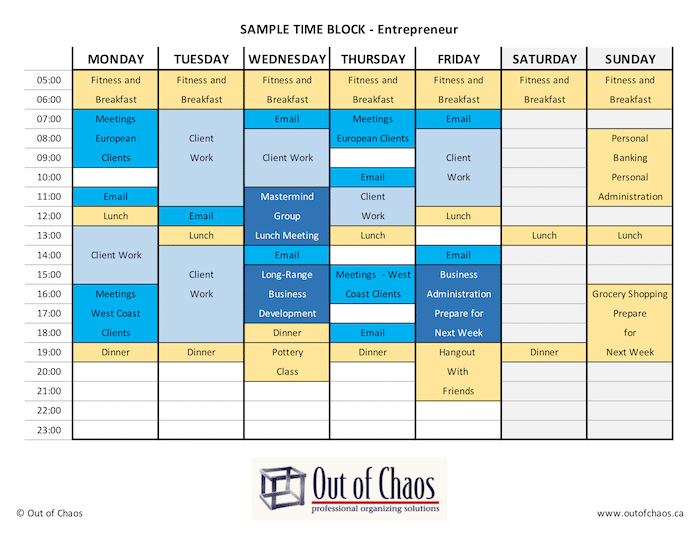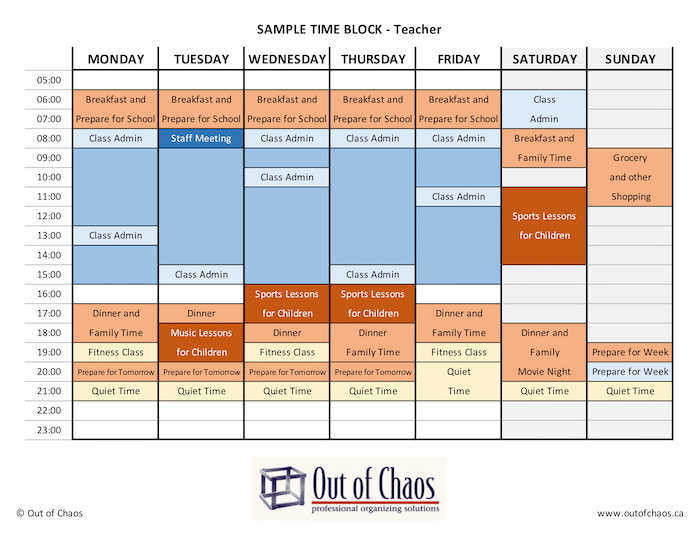
Time blocking is an effective way to schedule tasks and help you manage your time to be more productive.
When we maximize physical space, we put similar items in boxes and stack them in a closet. We can easily rearrange the boxes within the closet to better access the contents. But we can only put a certain number of boxes in the closet, which has a finite amount of space.
Just like the closet, our calendar has a finite amount of time. Instead of physical items, we have tasks on our to-do list. Many people would think of just scheduling items on their “to-do” list on their calendars, but time blocking is much more than that. Time blocking gives us “boxes” in which we can schedule our tasks. We can rearrange the time blocks on our calendar just like we arrange boxes in a closet.
How to Build Time Blocks
Start with a blank weekly view of your calendar. I have provided a template you can work with (pdf). It is divided into one-hour time blocks.
First, schedule items over which you have no control. You will want to schedule the time you sleep, have meals, and have permanent obligations such as taking the children to music/sports lessons, meetings with clients, etc. Remember to include preparation, clean-up, and travel time in your time block.
Next, schedule important but not urgent tasks. Block time in your calendar for long-term planning. Add both work-related and personal development projects such as reading and learning. Remember to schedule some self-care blocks, too.
Schedule blocks of time to work on specific tasks. Plan challenging work, such as writing proposals or creating a new design, for peak periods and less demanding work, like writing emails or ordering office supplies, for low-energy periods. Remember that you can (and should) take short breaks within a 3-hour working time block.
Finally, leave some blank space. Life is never as easy as you think it will be. Allowing yourself time between events will ensure you can cope with the unexpected.
Example: Teacher’s Time Blocks
On this teacher’s schedule, school-related tasks are coloured blue. Darker blue items, such as the staff meeting and teaching in the classroom, cannot be changed. The lighter blues are for class administration, such as lesson planning, marking papers, emailing parents, etc.
Orange-coloured time blocks are for family-related events. Darker orange time blocks are for events that cannot be changed, such as music lessons, and include travel time to and from the venue. Lighter orange events have some flexibility (e.g., preparation and clean-up times). Yellow is for personal time for self-care, reading, fitness, etc.
Example: Entrepreneur’s Time Blocks
This entrepreneur has coloured all work-related time blocks in blue. The bright blue events are all related to communication – email and client meetings. During the pale blue blocks, the entrepreneur works on client projects. The time blocks can be further divided depending on which project she works on during any given week. She might do design work in the mornings and write in the afternoon or vice versa, depending on her energy levels and the deadlines she needs to meet. The dark blue time blocks are slotted into the schedule so the entrepreneur can work on important but not urgent tasks. These will push her business forward in the long run. Personal time blocks are shaded yellow.
The Benefits of Time Blocks
The benefit is that the time blocks can be easily shifted around the calendar. For example, if Monday is a European holiday, the entrepreneur could easily shift the Monday meeting time block to Tuesday and move Tuesday morning’s client work block to Monday, ensuring the same amount of work gets done during the week.
Additionally, time blocking allows us to:
- Make time for important but not urgent tasks and improve our decision-making skills. For an in-depth look at these topics, see my post on becoming the Jedi Master of Time Management.
- Group similar tasks for greater efficiency. No one would go to the grocery store five times in one day for one item per trip. Likewise, answering emails every time you get a notification is equally inefficient. It is more effective to concentrate on one thing at a time than to switch from one task to another.
- Understand where we can multitask. Sometimes, assignments that require significant concentration can be done at the same time as tasks that require almost no effort. For example, doing laundry while writing an article.
- Be productive during both high- and low-energy periods. Schedule your most challenging work when you are ready to focus. When your energy levels drop, schedule the tasks requiring the least effort.
Time blocking can be an effective productivity tool for anyone, from entrepreneurs and consultants who have control over their own schedules to teachers and factory workers whose calendars are partially constrained by external factors.
Learn more about our productivity and time management services or contact us today.

